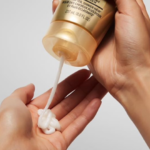What to Do When Hair Growth is Stunted (6 Easy Tips)
If you’ve ever hit a hair growth plateau, you know how frustrating it can be. It feels like your hair just won’t grow past a certain length, no matter what you do. The truth is, your hair might not be stunted in growth; it could be breaking off at the ends just as fast as it’s growing from the roots. This is where understanding how to fix stunted hair growth comes into play. Below, I’ve shared six easy tips that have helped me and many others move past the dreaded growth plateau.
1. Cleanse to Keep Your Scalp Healthy
A healthy scalp is the foundation of hair growth. Your scalp is responsible for nourishing the hair follicles, which directly influences how fast your hair grows. There’s a common myth that dirty hair grows faster, but that couldn’t be further from the truth. A dirty scalp can lead to clogged follicles, irritation, and even infection—all of which can stunt your hair’s growth. To fix stunted hair growth, it’s crucial to keep your scalp clean. I recommend washing your hair once a week with a gentle, sulfate-free shampoo. My go-to is Kinky Tresses Avocado Infusion Sulfate-Free Moisturizing Shampoo, which cleanses without stripping your hair of its natural oils. If your hair feels dry between washes, try co-washing to keep your scalp fresh and your hair moisturized.
2. Incorporate Scalp Massages
One of the simplest and most effective ways to stimulate hair growth is through regular scalp massages. By massaging your scalp with a nourishing hair oil, you can increase blood flow to your hair follicles, which encourages growth. I love using Kinky Tresses Nourishing Hair Oil for this. Just a few drops massaged into your scalp a few nights a week can make a noticeable difference over time.
3. Avoid Over-Manipulating Your Hair
If you’re constantly styling, combing, or otherwise manipulating your hair, you could be contributing to breakage that makes it seem like your hair isn’t growing. To fix this, try keeping your hairstyles simple. Protective styles like two-strand twists can be worn for several days without needing much adjustment. The less you manipulate your hair, the more likely you are to retain length. This approach also helps you avoid single-strand knots, which are notorious for causing breakage.
4. Minimize Heat Usage
While I’m not against using heat on my hair, I’m very careful about how often and how intensely I apply it. Heat damage is a major culprit behind split ends, dryness, and breakage, all of which can make your hair growth seem stunted. If you do use heat, always apply a heat protectant and keep the temperature at a moderate level. I try to limit my heat styling to once every few months, opting for heatless styles whenever possible.
5. Make Deep Conditioning a Habit
Deep conditioning is non-negotiable if you want to fix stunted hair growth and retain length. Deep conditioners not only infuse moisture into your hair but also strengthen it from the inside out. My favorite is the Kinky Tresses Avocado Infusion Restorative Conditioner. It’s especially important to focus on your ends, as they are the oldest and most fragile parts of your hair. I find it easiest to deep condition during every wash day, which takes the guesswork out of when to do it.
6. Trim Those Dead Ends
Trimming may seem counterintuitive when you’re trying to grow your hair, but it’s actually crucial. Holding onto split, damaged ends only leads to more breakage and makes your hair look thinner and less healthy. I recommend getting a trim every 3 to 4 months to keep your ends in good shape and to help retain length.
Understanding the Hair Growth Cycle
It’s also important to understand the natural hair growth cycle, which includes four phases: anagen (growth), catagen (transition), telogen (rest), and exogen (shedding). Each follicle on your scalp is in a different phase, which is why hair grows at different rates. Knowing this can help you manage your expectations and understand that hair growth plateaus are often temporary.
Why Hair Growth May Be Stunted
Beyond your hair care routine, several factors can stunt hair growth, including genetics, age, hormones, and stress. Conditions like alopecia, thyroid imbalances, and even certain medications can cause hair growth to slow or stop altogether. If you suspect an underlying health issue, it’s always best to consult with a healthcare provider for targeted advice and treatment.
Final Thoughts
Hair growth plateaus can be disheartening, but they aren’t permanent. By adopting these tips and understanding the factors that influence hair growth, you can work towards achieving the length you desire. Remember to document your journey with photos—progress may be slow, but it’s happening! If you’re still struggling with how to fix stunted hair growth, don’t hesitate to reach out to a professional for guidance.
Check Recent Posts:
- All-in-One Insurance Package: Comprehensive Coverage for Car, Health, and Family
- Top Benefits of Car Insurance for a New Car Owner 🚗
- What Does Conditioner Do for Curly Hair?

- How to Use Leave-in Conditioner for Curly Hair: A Step-by-Step Guide

- How to Brush Curly Hair the Right Way? Tips and Techniques

- The Truth About Leaving Conditioner in Your Hair Overnight: Pros, Cons, and Best Practices

